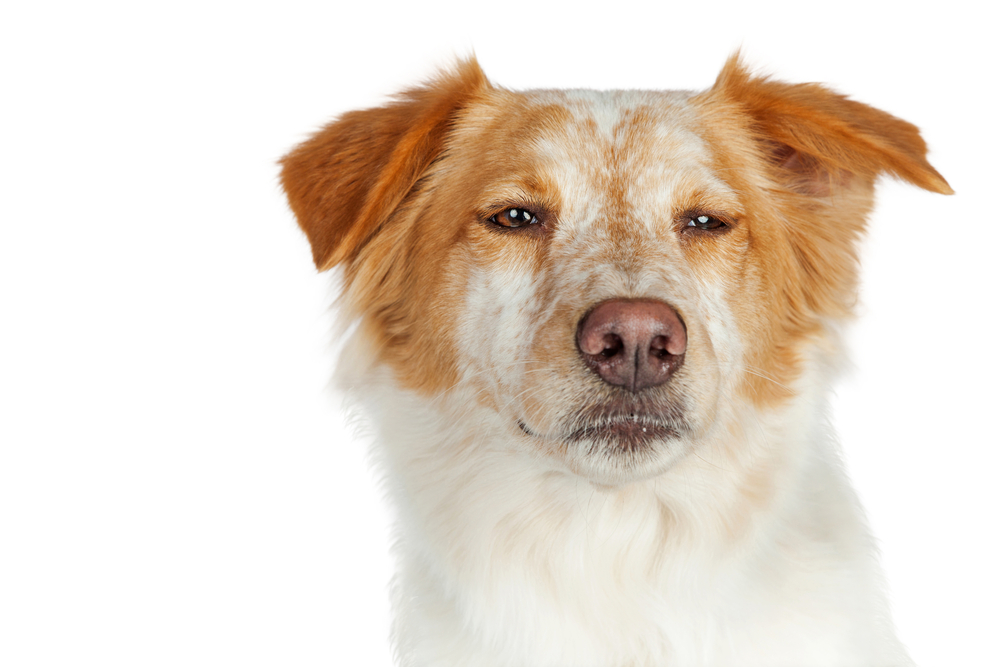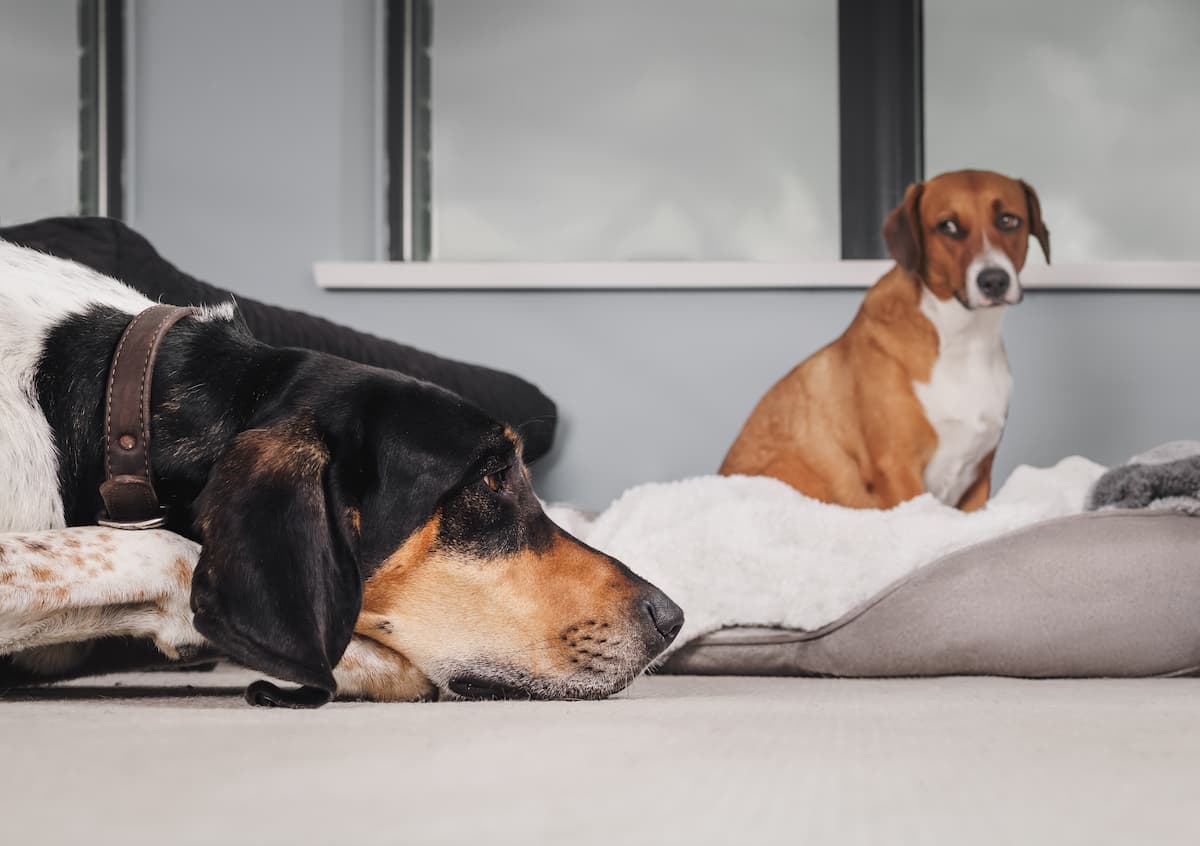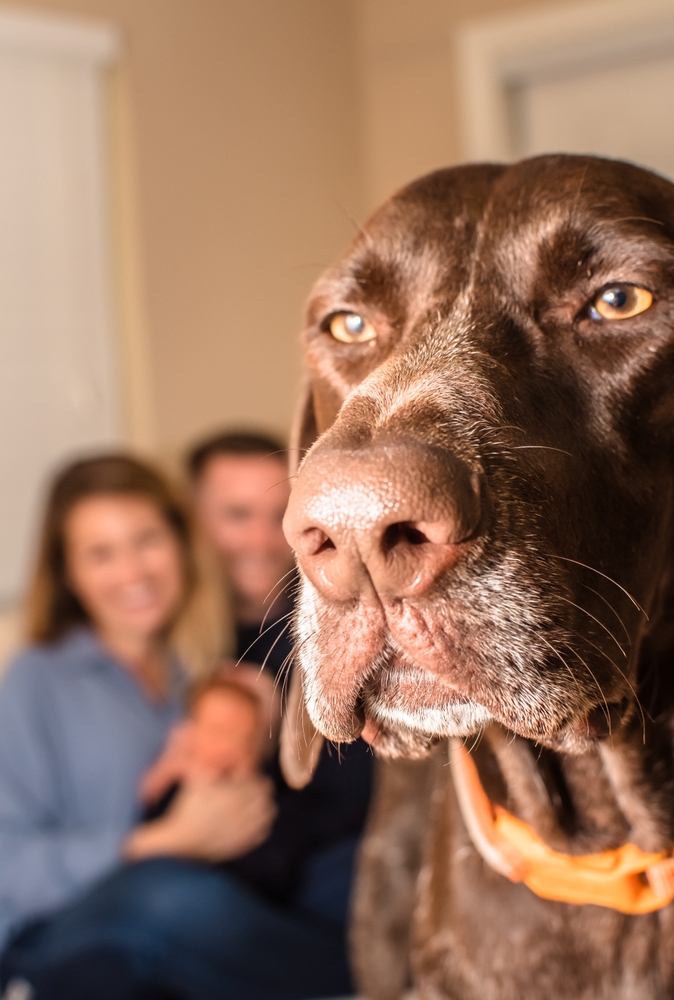With us humans, it’s pretty normal for the green-eyed monster to rear its head from time to time. But what about our furry friends? Have you ever wondered, “Do dogs get jealous?”
The answer is a resounding yes – dogs do get jealous! From a pupper becoming possessive of their Owner to a dog getting stressed about a new routine, there are numerous reasons why our four-legged friends experience jealousy.
If you reckon your dog might be indulging in some jealous behaviour, you’ll be glad to know it’s easily fixable. Let’s explore the most common factors behind jealousy in dogs and some simple ways to calm your pooch down.

“You’ve been spending time with that other dog, haven’t you?”
Do dogs get jealous? The research says yes!
Yep, that’s right! It was previously assumed that jealousy required a high level of cognitive ability and self awareness, limited mostly to adult humans. However, research shows that babies as young as six months old can feel jealous, although in a slightly more primitive way.
This is known as primordial jealousy, meaning it emerges in the very early stages of development. Primordial jealousy is rooted in social bonds, and usually happens when a loved one gives their attention to someone else. In this case, it’s whoever the baby is attached to.
So, what on earth do jealous babies have to do with jealous doggos?
Hear us out. A 2014 study found that dogs experience jealousy in much the same manner as infants. Dogs develop emotional attachments to humans just like babies do, which can naturally give rise to feelings of jealousy if something threatens a bond. This sure does give deeper meaning to the term ‘furbaby’!
Why do dogs get jealous?
As (hu)man’s best friend, dogs crave our attention. They want our undivided focus, love, and, let’s be honest, a constant stream of pats. If there’s a disruption to any of these, your pupper can become unusually attention seeking or even aggressive.
Sometimes, your dog may get jealous when you give attention to another pooch – perhaps when you’re out for a walk or at the dog park, or if you bring another dog into your home. They perceive the other dog as a threat to the deep bond that the two of you share, so they act out. In fact, research shows that dogs can get jealous when they simply imagine that their Owner is giving attention to a rival – even if that rival is a stuffed toy!
Dogs can also become jealous if there’s a new addition in the family, such as a baby. Naturally, your focus may shift towards your human baby and away from your furbaby. This can also happen if someone moves into your home or if a new human becomes your dog’s main caregiver. If you start spending time with a new partner, your dog may start to feel jealous of them, too. That sounds like one heck of a love triangle…
Jealousy in dogs can also be a result of other sudden changes, such as moving to a new home or adapting to a different routine. Maybe you’re working longer hours, or your usual walk time shifts to accommodate a new job. Dogs get anxious in such scenarios because their usual way of being gets a bit out of whack. Hey, even us humans can find these situations stressful!
 How do dogs show jealousy?
How do dogs show jealousy?
There are some tell-tale signs that your pooch is feeling jealous. Here’s what to look out for:
- Attention-seeking behaviour, such as getting between you and the perceived rival
- Barking, whining, or growling
- Aggression towards other people or dogs
- Anxious or nervous behaviour
- Pushing you or the perceived rival out of the way
- Leash pulling if you’re giving attention to another dog
- Being overly affectionate towards you
- Alternatively, just to make things more confusing, completely avoiding interaction with you or other dogs
What can I do about it?
We know firsthand how tricky (and often noisy) a jealous pupper can be. But fear not – for the sake of your sanity, safety, and eardrums, there are plenty of ways to curb jealousy in dogs.
#1: Call them to attention
A bit of basic training can go a long way in preventing jealousy from escalating. You could try teaching your dog simple commands like “leave it”, “no”, “down”, or “heel”. Having these tricks under your belt means that when heated situations arise, you’ll be able to get a good handle on your dog’s behaviour.
You can also start crate training so that your dog has a safe space to retreat to if they’re unsettled. Using a command like “go to your crate” can be super effective if your dog starts displaying signs of jealousy. A designated crate is particularly nifty if you’ve just moved house – it offers a tiny slice of familiarity when they’re adjusting to a new environment.
#2: Accentuate the positive
We know it can border on hilarious, but try to avoid laughing at your dog while they’re having a meltdown. Don’t give them a pat or offer treats or food. These are all forms of attention – and that’s exactly what your dog is trying to get! Instead, try a command, ignore them, or pull them out of the situation entirely. (This is where your pupper’s special crate can come in really handy.)
Once they’ve settled down, you can reward them with a treat or a healthy dog meal. That way, you’re reinforcing positive behaviour and showing your dog how you’d like them to act.
#3: Spread the love
If you’ve got multiple dogs at home, spreading the love around can help your furry friend feel less left out. Try to give each dog equal attention. If you’re settling in for a petting session, see if you can pat both dogs at once.
The same goes if someone new is living in your home, or if you’ve just welcomed a baby. Giving your furbaby a cuddle or taking them out for a walk can make them feel more included in your family unit.
#4: Lead them in a pack
Just adopted a new dog? Organise a group activity to help soothe your dog’s unease. You could take both dogs for a walk at the same time and encourage them to indulge in joint doggy behaviours. Puppers get such a kick out of travelling in a pack, exploring their surroundings, and peeing on absolutely everything in sight. When they do these things together, they’ll soon learn to get along and respect one another.
#5: If it’s a baby, go slow
Slow and steady is key when introducing dogs to babies. If there’s a new bubba at home, gently familiarise your dog with your baby’s smell. Have your pupper sniff one of your baby’s blankets or toys to ease them into having the actual baby around.
As a side note, if your furry friend is showing signs of jealous behaviour, don’t let your baby approach your dog or leave the two alone together. Some dogs will engage in ‘resource guarding’ (protecting items they see as valuable, such as food or toys) when they’re unsettled, which can cause them to lash out.
#6: Call in the experts
A new pet, baby, partner, or routine can understandably shift your focus away from your beloved pooch. If you simply don’t have the time to devote to your dog right now, you could think about calling in some expert assistance.
You might want to organise a visit to your local Pet Day Care so your dog can enjoy some quality human time. Otherwise, you could book a park date or walk with a trusted Dog Walker. This is a great option if you don’t have much time or energy on your hands. A bit of professional help is a win for you and a win for your doggo!

